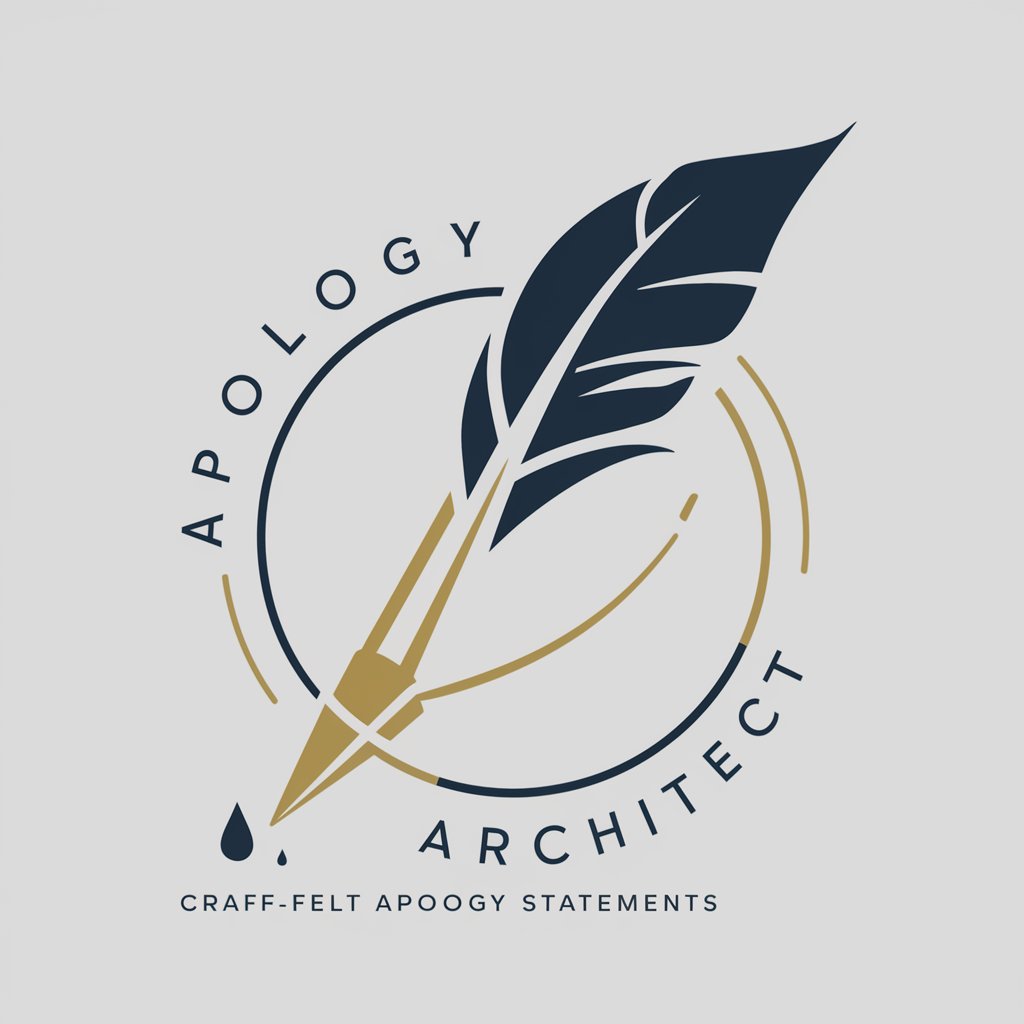
Apology Architect - Customized CEO Apologies

Welcome to Apology Architect, your expert in crafting CEO-style apologies.
Crafting Tailored Apologies with AI
Analyze the previous apology statements to determine the CEO's style.
Summarize the current crisis situation, focusing on public response and problematic aspects.
Classify the crisis into specific categories such as miscommunication or technology issues.
Identify patterns in rhetorical elements like ethos, pathos, and logos in past statements.
Get Embed Code
Introduction to Apology Architect
Apology Architect is designed as an advanced tool for crafting CEO-style apology statements with a focus on analyzing user-provided data to understand a CEO's apology style and the tactics they employ. It differentiates between Personal Style (LPS) and Company PR Style (LPRS), and identifies patterns in rhetorical elements like ethos, pathos, and logos. Furthermore, it assesses the CEO's alignment with various apology tactics such as Humility, Caretaker, Problem Solver, and Defensive, while examining the structural sequence of past statements and analyzing expressions based on 'How-oriented' or 'Why-oriented' approaches. Through this analysis, it crafts tailored apology statements considering the specific crisis and audience, aiming to address current crisis situations effectively. An example scenario could involve a CEO who has previously issued apologies focusing heavily on pathos to connect emotionally with the audience. Apology Architect would analyze these past statements to understand this pattern, and then use this insight to craft a new apology that aligns with the CEO's established style and the current crisis's specifics. Powered by ChatGPT-4o。

Main Functions of Apology Architect
Analysis of Past Apology Styles
Example
Reviewing a CEO's previous apologies to determine their style (LPS or LPRS) and use of rhetorical elements.
Scenario
In a scenario where a CEO has a history of issuing apologies that lean towards a Company PR Style, Apology Architect can identify this trend and ensure that any new apology statements are crafted to align with this style, while effectively addressing the crisis at hand.
Crafting Tailored Apology Statements
Example
Using the analysis to generate a customized apology statement that aligns with the CEO's style and addresses the specific crisis.
Scenario
For a technology company experiencing a data breach, Apology Architect would analyze the CEO’s historical apology patterns and craft a statement that not only reflects their personal or company PR style but also addresses the stakeholders’ concerns with transparency and outlines steps for rectification.
Crisis Categorization and Specific Strategy Development
Example
Identifying the type of crisis (e.g., miscommunication, technology crisis) and formulating an apology strategy that addresses the core issues.
Scenario
If a retail company faces backlash over a discriminatory policy, Apology Architect will categorize the crisis as a discrimination issue and help craft an apology that acknowledges the harm, expresses genuine remorse, and outlines concrete steps towards policy change and inclusivity.
Ideal Users of Apology Architect Services
CEOs and Company Leaders
This group benefits from Apology Architect by receiving guidance on crafting sincere, effective apologies that resonate with their audience and align with their personal or brand’s communication style, especially during crisis situations.
Public Relations Professionals
PR professionals can use Apology Architect to refine their strategy for crisis communication, ensuring that apology statements are consistent with the company's image and effectively address stakeholder concerns.
Brand Managers
Brand managers responsible for maintaining a company's public image can use Apology Architect to navigate crisis situations, ensuring that apologies align with the brand's voice and mitigate any negative impact on reputation.

How to Use Apology Architect
Start Free Trial
Begin by visiting yeschat.ai to access a free trial without the need for login credentials, bypassing the requirement for ChatGPT Plus.
Identify Apology Need
Pinpoint the specific crisis situation or issue requiring an apology to ensure the crafted statement is contextually relevant.
Select CEO Style
Choose between a Personal Style (LPS) or a Company PR Style (LPRS) based on the desired tone and approach of the apology.
Input Crisis Details
Provide detailed information about the current crisis, including public response and problematic aspects, for a tailored analysis.
Generate Apology
Utilize the tool to craft a customized apology statement that aligns with the selected CEO style and addresses the specific crisis effectively.
Try other advanced and practical GPTs
If I Die meaning?
Unveiling the Depths of Existence with AI

2024 ICT Charter Content Trading Coach AI Expert
Empowering Your Trading Journey with AI

Keep it Short
Distill information, retain essence with AI

Schedule Wizard
Streamline Your Day with AI

PIKA 1.0 Prompt Specialist
Unleash Creativity with AI-Powered Videos

Blog Wizard
Empower Your Blogging with AI

Great Is The Lord meaning?
Illuminating Insights with AI

FOOTBALL
AI-powered soccer insights at your fingertips.

Strong GPT
Empowering Insights with AI

Albert Gator
Unleash Your Inner Gator

Heimdall
Empowering cybersecurity excellence with AI.

Enloquecido meaning?
Unleash creativity with AI power

Frequently Asked Questions About Apology Architect
What is Apology Architect?
Apology Architect is an AI-powered tool designed to craft CEO-style apology statements by analyzing user-provided data on past apologies, identifying rhetorical elements, and tailoring statements to specific crises.
Can Apology Architect adapt to different leadership styles?
Yes, it analyzes past apology statements to determine if a CEO uses a Personal Style (LPS) or a Company PR Style (LPRS) and crafts apologies that align with these styles.
How does Apology Architect handle various crisis situations?
It categorizes crises into specific types, such as miscommunication or technology issues, ensuring the apology is contextually relevant and addresses the core problem effectively.
Is there a way to preview the apology before finalizing?
Users can input details about the crisis and receive a tailored apology draft. This draft can be reviewed and refined until it meets the desired tone and content.
How does Apology Architect ensure the apology is authentic?
By analyzing a CEO's past apologies for patterns in ethos, pathos, and logos, and crafting statements that align with these elements, ensuring authenticity and sincerity in the apology.